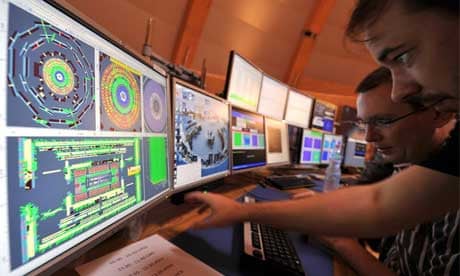A giant scientific instrument that was designed to recreate the big bang but blew itself up in the process will be back in business on Friday.
Scientists at the Large Hadron Collider (LHC) at Cern, the nuclear research organisation near Geneva, aim to have beams of subatomic particles whizzing around the machine on Friday evening, and will begin smashing them together soon after.
The first collisions will mark the end of a long and frustrating period for the researchers, who waited eight years for the machine to be built only to see it explode shortly after being switched on in September last year. Repairs and a new safety system cost an estimated £24m.
The machine, which occupies a 27km tunnel 100m beneath the French-Swiss border, will probe some of the deepest mysteries of the universe by crashing subatomic particles into one another at close to the speed of light.
The collisions are expected to reveal tantalising signs of new physics that could include extra dimensions of space and "supersymmetry", a theory that calls for every particle in the universe to have an invisible partner.
Scientists also hope the machine will finally discover the elusive Higgs boson, aka the God particle, which imbues other particles with mass. It may also expose the nature of dark matter, a mysterious, invisible material that stretches across the cosmos and collects around galaxies.
The £6bn machine was shut down last year after a spark caused by faulty wiring tore a hole in the collider and released liquid helium, wrecking surrounding equipment and encasing it in a layer of ice. Engineers have spent the past year checking the wiring in the rest of the machine and installing safety measures to prevent another catastrophe.
Work on the machine was interrupted earlier this month when a short circuit took out an electrical substation. The incident was blamed on a piece of baguette dropped by a passing bird.
The first collisions will be at low energies but will give scientists working on the machine's four giant detectors their first real data to work on.
Two beams of subatomic particles called protons, travelling in opposite directions around the tunnel, will be accelerated to almost the speed of light. At four points around the ring the beams will cross over, slamming the protons into each other head-on. The violent impacts will release fleeting bursts of energy that will recreate in microcosm the conditions that existed only a fraction of a second after the big bang.
Lyn Evans, who has overseen the construction of the LHC for the past 15 years, said Cern hoped to get two beams of protons circulating in the machine on Friday evening. "Then we just have to steer them into one another," he said. Collisions are expected to reach an energy of 2.2 trillion electronvolts by Christmas, enough for the LHC to take the title of the most powerful particle collider in the world.
By January, the machine should be running with at least three times as much energy as the current world-leading particle smasher, the Tevatron at Fermilab near Chicago.
"It's been a frustrating time, but what we do know is that the machine works beautifully," Evans said. "By Christmas, I expect we will take the high-energy frontier, if only by a whisker."
Cern engineers have already sent beams of particles half way around the machine. Their first goal later this week will be to circulate two beams of protons at low energy, the stage they reached this time last year before the machine exploded.
The first low-energy collisions will give scientists a chance to check the machine is working properly and ensure its detectors are recording the beautiful streaks of subatomic debris created when the particles crash into one another.
The machine will close for a couple of weeks over Christmas while engineers finish installing safety measures to prevent the machine exploding again when it is running at higher energies next year.
Jim Virdee, a physicist at Imperial College, London, and spokesman for the machine's giant CMS (Compact Muon Solenoid) detector, has spent the past year calibrating the detector by watching high-energy particles in cosmic rays hurtle through it.
"There's a mood of great anticipation here. We're cautiously optimistic and looking forward to finally getting going," he said. "We will soon be making great inroads into new territory. We'll be looking for new things, but what we find depends on how kind nature is to us."
Some scientists are relying on the LHC to pull physics out of at least a decade in the doldrums. While theoretical physicists have pushed ahead with string theory and other models that describe the particles and forces of nature, experiments to prove any of them right or wrong have been lacking.
Last year, an American court dismissed a legal challenge that claimed the LHC might destroy the planet by creating a black hole or a clump of matter known as a strangelet. This year, physicists at the Niels Bohr Institute proposed an even more extraordinary possibility. Their calculations suggested that the long-sought Higgs boson was so abhorrent to nature that any machine that tried to make it would be "sabotaged" from the future. Few scientists are losing sleep over the prospect.
"We are absolutely and totally confident that the machine is perfectly safe, just as we were last year," said Evans. "And i'm not at all worried about the it being destroyed by its own future."
